|
|
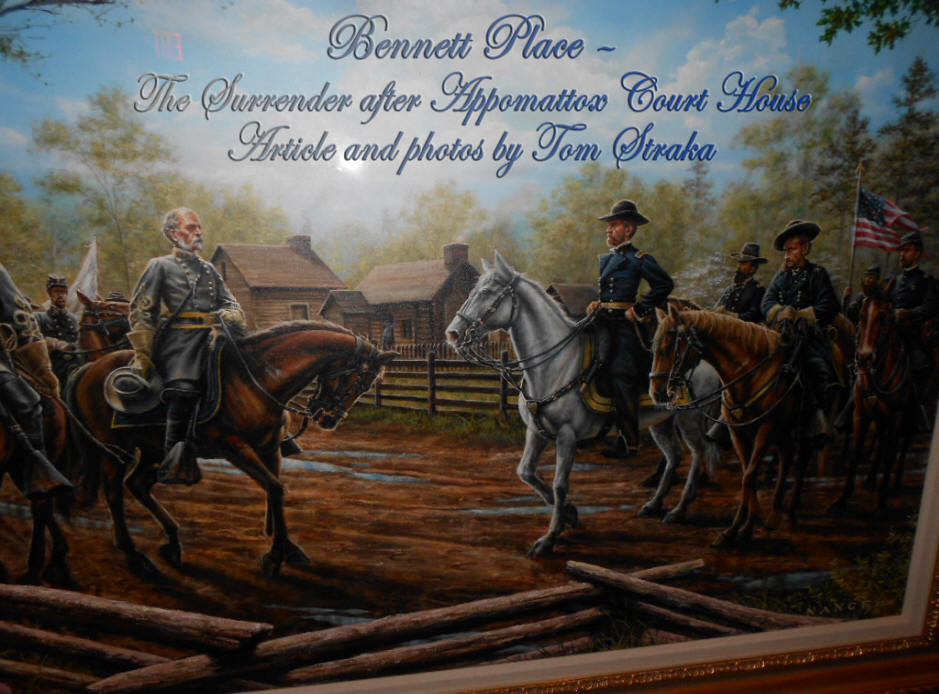
You
probably think the last surrender of the Civil War took place at
Appomattox Court House. Not so, there were several others as
Confederate troops further south and west surrendered.
Confederate President Jefferson Davis did not want the war to
end with Appomattox. By early-April 1865 it was apparent that
the Civil War was drawing to a close. General William T. Sherman
and his Union troops had finished their march to the sea and
were now marching through the Carolinas. Columbia, South
Carolina was burned in mid-February and in mid-March Sherman's
objective in North Carolina became clear; he was headed to
Goldboro to linkup with 30,000 additonal Union troops moving
west from the coast. Goldsboro
was important as it openned the door to Raleigh and the
important rail lines going north (the rail line that supplied
the besieged Army of Northern Virginia). Sherman hoped to move
north rapidly and join in the expected surrender of
General Robert E. Lee
and the Army of Northern Virginia.
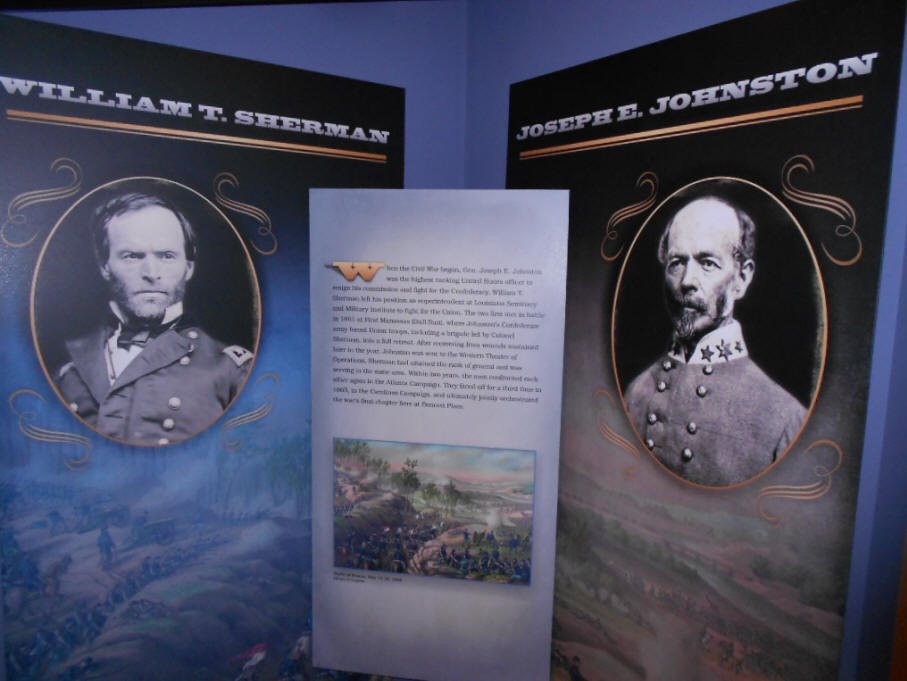 |
|
Two general who helped write the final chapter of
the American Civil War. |
General Joseph E. Johnston was in charge of the Confederate
effort to thwart Sherman.
The last major battle of the Civil War and the largest
ever fought in North Carolina would be at Bentonville where
Johnston attempted to ambush Sherman's troops. He failed to stop
Sherman and moved his troops east. In early April, Richmond and
Petersburg fell in Virginia and Sherman knew he had limited time
to finish his Carolinas Campaign if he were to participate in
Lee's surrender. But that surrender came quickly on April 9,
1865 and Sherman found out about it on April 11. President Davis
felt the war should go on. Finally convinnced by his cabinet
that a guerrilla war would just prolong inevitable results,
Davis agreed that General Johnston should contact General
Sherman and discuss peace terms.
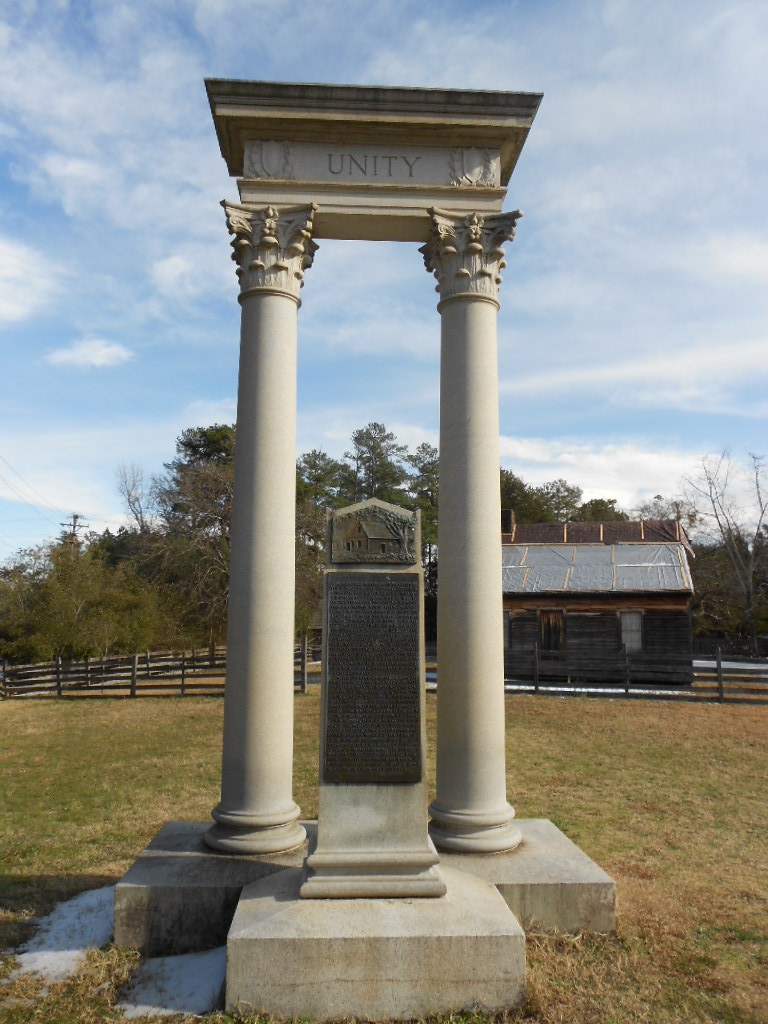 |
Unity Monument, dedicated in 1923 as a symbol of
national unification. The two white columns
represent the Confederacy and the Union and are joined
at the top with a unity bridge. |
General Sherman had met with General Grant and President Lincoln
in early March to discuss possible surrender terms, so he was
prepared for surrender talks. Still, Sherman expected a final
battle for Raleigh. It never happened. Confederate troops and
the governor left Raleigh and on April 12 a group of promient
Raleigh citizens pleaded for Sherman to spare Raleigh from
destruction.
Sherman agreed and his troops entered the city on April 13.
Headquarters for the troops was the governor's mansion. The next
day Sherman received a message under a flag of truce requesting
a cesssation of hostilities so that civilian authories could
negotiate for peace. Sherman agreed to meet Johnston halfway
between their two locations, Hillsborough and Raleigh. That was
near a small station on the railroad line: Durham's Station
(current day Durham). Just as Sherman was leaving for Durham's
Station on April 17, he received word of Lincoln's
assassination. He did not want to imperil the peace talks, so he
swore the telegraph operator to secrecy.
The two generals met in an area of open fields and woodlands and
concluded they needed a building to meet in that would allow
privacy. Johnston had passed a cluster of houses, so the two,
accompanied by calvary, went there looking for a meeting place.
The first homeowner approached would not allow a Yankee in his
home, so they continued on to the farm of James Bennitt (later
spelled Bennett). The Bennitt family had lost two sons and a
son-in-law in the war. The family retreated to the nearby log
kitchen building to give the generals privacy.
Sherman described the
meeting as:
They met [flag bearers carrying flag of truce], and word was
passed back to us that General Johnston was near at hand, when
we rode forward and met General Johnston on horseback, riding
side by side with General Wade Hampston. We shook hands, and
introduced our respective attendants. I asked if there was a
place convenient where we could talk in private, and General
Johnston said he had passed a small farm-house a short distance
back. . . . We soon reached the house of a Mr. Bennitt,
dismounted, and left our horses with orderlies on the road. Our
officers, on foot, passed into the yard, and General Johnston
and I entered the small frame-house. We asked the farmer if we
could have use of his house for a few minutes, and he and his
wife withdrew into a smaller log-house, which stood close by.
General Sherman shared the secret telegraph with General
Johnston, changing the tone of discussions. Johnston felt that
Lincoln's death "was the greatest possible calamity ot the
South." Sherman offered Johnston the same terms that Grant had
offered Lee. However, Johnston felt their goal should be a
suspension of hostilities so that civilian authorities could
work out an end to the war. No decision was reached on the 17th
and both returned to their respective sides. A second meeting
occurred the next day at the same place. Johnston told Sherman
he felt he had authority to surrender all Confederate field
troops. Sherman offered terms similair to those offered by Lee
to Grant, but more generous. There was debate later on whether
those terms followed the plans outlined by Lincoln. When the
surrender terms arrived in Washington, Secretary of War Stanton
and Congress felt they were too generous. Washington rejected
them. Sherman and Johnston met again on April 26 and worked out
terms closer to what Grant had given Lee. Washington accepted
those terms.
Lee had surrendered the 28,000-man Army of Northern Virginia.
Johntson surrendered 90,000 troops in the Carolinas, Georgia,
and Florida. President Davis very much wanted the war to
continue, even as a guerrila action. He was not alone among
Confederates. Had the Bennett Place surrender not occurred,
Appomattox Court House could well not be where most Civil War
histories end.
Bennett Place Today
 |
|
Museum display of items that might have been in the
farmhouse.
Drop-leaf table, Bennett family pitcher,
spool chairs, and portraits of Eliza and Lorenzo
Bennett.
|
After the war the site was spurned by North Carolinans, who were
not fond of the surrender. A new owner in 1919 had the idea of a
park, but the house, except for its stone chimmney,
burned to the ground in 1921.
|
|
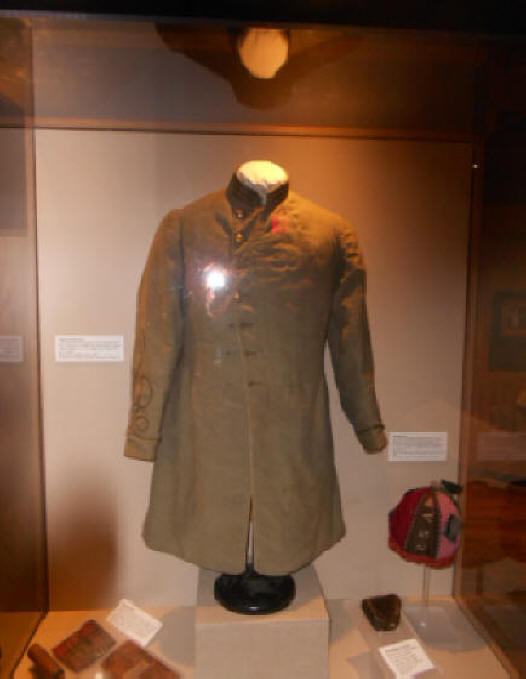 |
| |
Confederate frock coat in museum. |
In 1923 a member of the North Carolina General Assembly obtained
an agreement to erect a Unity Monument on the site in exchange
for a 3 � acre grant. The monument was to mark national unity
(between Sherman and Johnston), as opposed to clebrating a
surrender. Prior the Civil War centennial, interest peaked in
Bennett Place.
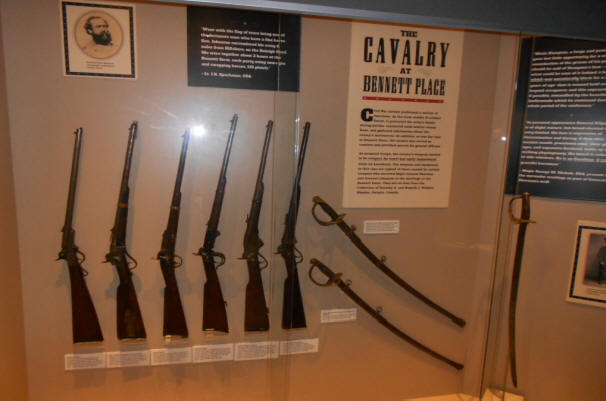 |
| The museum includes weapons |
A condemened house that was very similair to the
Bennett hosue was moved to the site and restored, along with a
separate kitchen house, and smokehouse. Later, a visitors center
was constructed on the site, with an auditorium and museum. The
site is located within the city limits of Durham, very close to
Interstate 85.
Author:
Tom Straka is a forestry professor at Clemson University in
South Carolina. Photogrpahs by author.
American Roads and
Global Highways has so many great articles you may
want to
search it for you favorite places or new exciting destinations.
|
![]() Ads fund American Roads and Global Highways
so please consider them for your needed
purchases.
If you enjoy the articles we offer, donations
are always welcome.
Ads fund American Roads and Global Highways
so please consider them for your needed
purchases.
If you enjoy the articles we offer, donations
are always welcome.
--------
|